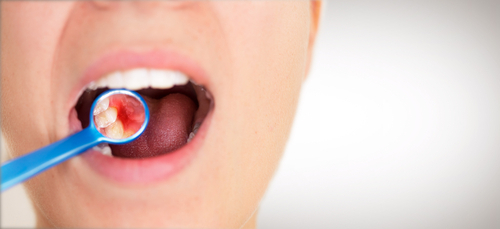
Do you experience constant gum bleeding when brushing your teeth? This actually might indicate gum disease. According to the Centers for Disease Control and Prevention, nearly 42% of adults aged 30 years and older have some form of periodontal disease. Gum disease increases with age, about 70% of adults aged 65 years and older have the disease. Risk factors of periodontal disease include smoking, diabetes, poor oral hygiene, stress, and many other things.
So, what gum disease is? This is a serious chronic condition in which a certain type of bacterial infection actively attacks the gums and often the bone surrounding a tooth. The disease starts from a thin layer of plaque on the teeth which typically forms when they are not cleaned well. The bacteria spread to the gums over time and eventually reach the tooth-supporting bone. Once the condition progresses, it leads to tooth loosening and shaking. The final step is tooth loss. Therefore, it’s a bad idea to ignore the issue once you start feeling discomfort in your gums.
1. Symptoms of gum disease
Signs of gum disease include:
Bad breath
Bleeding gums during brushing or flossing
Gum inflammation and swelling
Bad or bitter taste in the mouth
Bite changes
Pus pockets in between the teeth
Tooth loss
Gum disease symptoms above are the most common and require medical attention.
2. Stages of gum disease
There are three stages of periodontal disease:
1. Gingivitis
Gingivitis is the first stage of gum disease which starts with the accumulation of plaque on the gums. It usually occurs due to poor brushing - the plaque from the teeth is not removed well and releases toxins that irritate the gum line. Gingivitis is easy to treat since the bacteria haven’t entered deeper into the gums yet.
2. Periodontitis
Periodontitis is the second stage of periodontal disease which is characterized by tartar formation which begins to destroy gum tissue causing the gums to bleed and recede. Once gums recede, small puss pockets occur in between the teeth creating more room for bacteria to multiply. Moreover, food particles get trapped in these pockets which feed the bacteria. If left untreated, periodontitis can progress onto the third stage.
3. Advanced periodontitis
Advanced periodontitis is the last stage of gum disease which is accompanied by huge damage to the gums and teeth-supporting bones. This eventually leads to loss of teeth.
3. Gum disease treatment options
Currently, gum disease can be treated in several ways which include:
1. Scaling or deep cleaning
If the gum disease enters deeply in the mouth, a superficial cleaning won’t help. In this case, you may need deep cleaning. During the procedure, your doctor will clean under the gum line and scrape off tartar above and below the gumline.
2. Cosmetic dental surgery
The third stage of periodontal disease is always accompanied by gum recession and requires cosmetic dental surgery that involves the removal of inflamed gum tissue and reshaping. As with any type of procedure, you run the risk for infection or bleeding, therefore it’s essential to choose a skilled and experienced dentist.
3. Gingival grafting
Gingival grafting is required if your periodontal disease is advanced. Your doctor will cut and remove the healthy gum tissue from a different part of the mouth and sew it back in place.
4. Proper oral hygiene
Proper oral hygiene is a crucial part of gum disease treatment. Regular brushing will hinder bacteria multiply in your mouth for too long and help you manage the disease.
5. Enzyme suppressant
An enzyme suppressant is a tablet given after a detailed cleaning in the mouth. It works by inhibiting specific enzymes produced by bacteria that break gum tissues down.
6. Antibiotics
Antibiotics are aimed at treating bacterial infection and mouth inflammation and can be taken in the form of gels, mouthwashes, or tablets.

